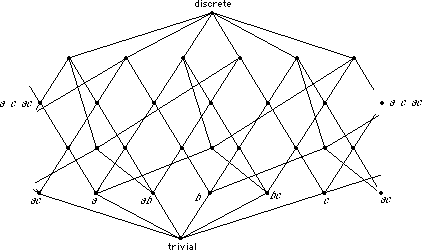- int(Q) =
 ; cl(Q) = R
; cl(Q) = R
- int(Q) = cl(Q) = Q
- int(Q) =
 ; cl(Q) = R
; cl(Q) = R
- int(Q) =
 ; cl(Q) = R
; cl(Q) = R
- int(Q) =
 ; cl(Q) = Q
; cl(Q) = Q
- int(Q) =
 ; cl(Q) = R
; cl(Q) = R
- int(A) =
 ; cl(Q) = {1, 2, ... , 48}.
; cl(Q) = {1, 2, ... , 48}.
- int(2N) =
 ; cl(2N) = N
; cl(2N) = N
- Both follow from the fact that every interval contains both rational and irrational points.
- It is easy to verify that any infinite set is dense.
 cl(B) is a closed set which contains A
cl(B) is a closed set which contains A  B and so it also contains cl(A
B and so it also contains cl(A  B).
B).Take A = (0, 1) and B = (1, 2). Then A
 B =
B =  and cl(A
and cl(A  B) =
B) =  while cl(A)
while cl(A)  cl(B) = {1}.
cl(B) = {1}.
If C  D then int(C)
D then int(C)  int(D) (since int(C) is an open subset of D). Also int(A
int(D) (since int(C) is an open subset of D). Also int(A  B)
B)  int(A) and similarly int(A
int(A) and similarly int(A  B)
B)  int(B). Hence int(A
int(B). Hence int(A  B)
B)  int(A)
int(A)  int(B).
int(B).
Also int(A)  int(B) is an open subset of A
int(B) is an open subset of A  B and hence lies in int(A
B and hence lies in int(A  B). Thus the two sets are equal.
B). Thus the two sets are equal.
int(A)  int(B) is an open subset of A
int(B) is an open subset of A  B and hence lies inside int(A
B and hence lies inside int(A  B).
B).
The other inclusion may fail. For example take A = [0, 1] and B = [1, 2] in R (with the usual topology). Then int(A  B) = (0, 2) while int(A)
B) = (0, 2) while int(A)  int(B) = (0, 2) - {1}.
int(B) = (0, 2) - {1}.
In the cofinite topology on R, the subset 2Z is not closed and hence it is not closed in the subspace topology on Z. So the topology on Z is not discrete
 , X, {a}} and {
, X, {a}} and { , X, {b}}. The last two are homeomorphic.
, X, {b}}. The last two are homeomorphic.To handle X = {a, b, c} note that X and
 are always open and we will list the others (leaving out the { }'s and commas).
are always open and we will list the others (leaving out the { }'s and commas).One extra set: (3 sets in all)
a, b, c, ab, ac, bc
We have 6 topologies in all -- 2 up to homeomorphism.
Two extra sets: (4 sets in all)
a, ab (6 like this)
a, bc (3 like this)
We have 9 topologies in all -- 2 up to homeomorphism.
Three extra sets: (5 sets in all)
a, b, ab (3 like this)
a, ab, ac (3 like this)
We have 6 topologies in all -- 2 up to homeomorphism.
Four extra sets: (6 sets in all)
a, b, ab, ac (6 like this)
We have 6 topologies in all -- 1 up to homeomorphism.
Together with the trivial (2 sets) and discrete (8 sets) topologies, this gives the full list of 29. Up to homeomorphism there are 9 topologies.

Here is a "lattice diagram" showing how they are related.
Topologies with the same number of sets are on the same level.
[The {ac} and {a c ac} "points" have been plotted twice to make the diagram more symmetric.]